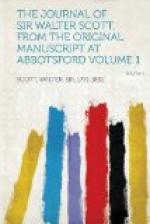“W.S."[463]
On the 15th September
he tells the Duke of Buccleuch, “I am going
to try whether the air
of Naples will make an old fellow of sixty
young again.”
On the 17th the old
splendour of the house was revived. Col.
Glencairn Burns, son
of the poet, then in Scotland, came
“To stir with joy the towers of Abbotsford.”
The neighbours were
assembled, and, having his son to help him, Sir
Walter did the honours
of the table once more as of yore.
On the 19th the poet Wordsworth arrived, and left on the 22d.
On the 20th, Mrs. Lockhart
set out for London to prepare for her
father’s reception
there, and on the 23d Sir Walter left Abbotsford
for London, where he
arrived on the 28th.[464]]
FOOTNOTES:
[456] Falconer’s Shipwreck, p. 162—“The Storm.” 12mo ed. London, Albion Press, 1810.
[457] Scotch Metrical Version of the 90th Psalm.
[458] On the 18th October Sir Walter sent Mr. Burn the following inscription for the monument he had commissioned, and which now stands in the churchyard of Irongray:—
“This stone was erected by the Author of Waverley to the memory of Helen Walker, who died in the year of God 1791. This humble individual practised in real life the virtues with which fiction has invested the imaginary character of Jeanie Deans; refusing the slightest departure from veracity, even to save the life of a sister, she nevertheless showed her kindness and fortitude, in rescuing her from the severity of the law, at the expense of personal exertions, which the time rendered as difficult as the motive was laudable. Respect the grave of Poverty when combined with the love of Truth and dear affection.”
It is well known that on the publication of Old Mortality many people were offended by what was considered a caricature of the Covenanters, and that Dr. M’Crie, the biographer of Knox, wrote a series of papers in the Edinburgh Christian Instructor, which Scott affected to despise, and said he would not read. He not only was obliged to read the articles, but found it necessary to inspire or write an elaborate defence of the truth of his own picture of the Covenanters in the Number for January 1817 of the Quarterly Review.
In June 1818, however, he made ample amends, and won the hearts of all classes of his countrymen by his beautiful pictures of national character in the Heart of Midlothian.
It is worth noticing also that ten years later, viz., in December 1828, his friend Richardson having written that in the Tales of a Grandfather “You have paid a debt which you owed to the manes of the Covenanters for the flattering picture which you drew of Claverhouse in Old Mortality. His character is inconceivable to me: the atrocity of his murder of those peasants, as undauntedly devoted to their own good cause as himself to his, his personal (almost hangman-like) superintendence of their executions, are wholly irreconcilable with a chivalrous spirit, which, however scornful of the lowly, could never, in my mind, be cruel,” Scott, in reply, gave his matured opinion in the following words:—




